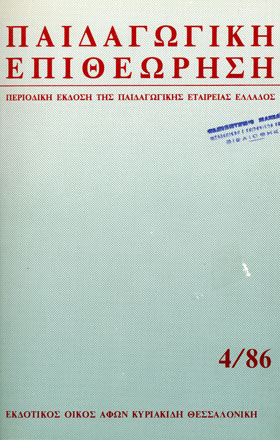Γιατί να εφαρμοστεί το ενιαίο σχολείο; κάποιες σουηδικές απόψεις
Main Article Content
Περίληψη
A strong force behind the quest for a comprehensive school in Sweden consisted of the labour movement and the worker's educational organization, after the turn of the century. The main motive for a structural reform was in their view to provide increased equality by providing equal access to further going education irrespective of social class and place of residence. This reform by and large was carried by political consensus. The discussion some 25-50 years ago about the pros and cons for comprehensivization of mandatory schooling suffered from one pervasive weakness: both proponents and adversaries of a comprehensive structure confused diagnosis and prognosis. A follow-up study conducted by the 1957 School Commission, which made the recommendations for the introduction of a comprehensive school all over the country showed that the number of failures increased after the first year in the real kola. This must be due either to a poor diagnosis on the part of the receiving school or to changes within the pupils or to a combination of both. We know now more about how pupils change during their teens than we did some 25 years ago. As it results from the relevant research, to suggest that young people can begin to make a responsible commitment to a career before the age of, say, 15-16 or may be even 17-18, is to indulge in an illusion. The argument, which is frequently used to justify early separation of the academically gifted from giving separate instruction to children of outstanding intellectual ability is not valid for many reasons. Such a reason is that no account is taken of the price paid in a selective system for the product that reaches the graduation stage. If, as has been and still is the case in several countries, half or more than half of those admitted on a competitive basis to the Gymnasium or the Lycee drop out along the way, then the price paid for the final products in terms of not only individual frustrations but social wastage as well is indeed very high. The Studies which were conducted at the Stockholm School of Education in the late 1950s and early 1960s were after two kinds of facts, both crucial, in the debate on the relative advantages and disadvantages of the comprehensive and parallel systems respectively: a) how are the pupils developing cognitively in the two systems? To what extent is there wastage of academic talent in the comprehensive system as compared to the selective? This was in the debate going on in Sweden in the 1950s and later on the continent and in England, considered to be the key problems, because the reform issue was conceived mainly in pedagogical terms and not as a social reform, b) What kind of wastage of academic talent occurs in the traditional system as a result of selectivity at an early age? The Stockholm study was crucial in directing the attention of the policy-makers and some educators to this aspect of the comprehensivization issue. They found that whatever criteria used in the selection procedure they are all correlated with social background. What has been said so far could be regarded as an advocacy for a flexible and truly elective comprehensive education, but it is also important to point out that comprehensivization does not mean gray uniformity in provisions of educative experiences. We must be wary about guarding the principle of flexibility and selectivity. Furthermore comprehensivization is not a panacea against what appears to be a pervasive feature of modern industrial societies, namely the creeping diploma disease which reflects a growing element of meritocracy. We have to live with the equality-meritocracy dilemma in the school as long as the growth philosophy prevails. This does not in the long run augur too well for comprehensive education.
Article Details
Τεύχος
Ενότητα
Άρθρα
